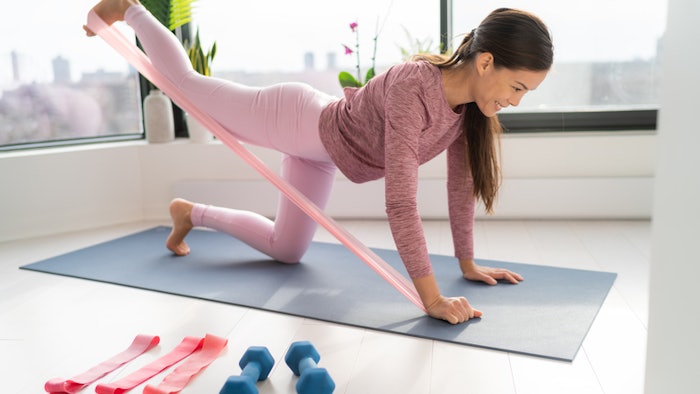
The Wellness Experience by Organic Spa Media recently took place April 13-14, 2021. During the event, a panel of fitness experts came together to discuss the latest fitness trends, many of which emerged during the pandemic and look like they're here to stay.
The expert panel was:
- Taylor Rae Almonte, Cofounder of ACTIV-ISM
- Lauren Korzan, Regional Program Manager of Aquila
- Dr. Andrew Jagim, Director of Sport Medicine Research for the Mayo Clinic
- Dr. Kevin Sprouse, Head of Medicine for EF Education First Pro Cycling
- Lisa Niren, CEO of Studio
According to these experts, here are the top four post-pandemic fitness trends that are here to stay.
1. Virtual Fitness
Consumers will continue to take advantage of virtual fitness classes, whether on Instagram or via the provider's own platform. Brick and mortar group classes will of course return—there will always be a need for that, as many people don't have the space to work out at home, or simply prefer the sense of community they get from attending a fitness class in person. However, the most successful businesses will likely be the ones that are able to offer virtual options, i.e., a hybrid model will be ideal moving forward.
Related: 10 Fitness Trends Emerging in 2021
2. At-Home Equipment
There's currently a wealth of workout equipment that can be used in the home. For those new to fitness, the panel recommended versatile options that make it easy to exercise in a living room while taking money and space into account. This can include resistance bands, kettlebells and exercise balls—anything that provides some resistance and will allow people to get in a good workout with minimal equipment in a range of home environments.
Those who are more athletic turned to using what they already had, but in a different way. For example, someone who was a regular cyclist may have transitioned over to something like Peloton, which is a stationary bike with software that provides them a sense of community. Because athletes tend to enjoy being able to do a workout with a group and then step away, this sort of workout will remain popular.
3. Wearables and Data
Wearables can be especially helpful in terms of sleep and recovery, but they can also serve to be motivational. For example, people who enjoy social media aspect can tag mentors or friends in their workouts. Regarding the pandemic and the isolation that came along with it, this kind of community kept people accountable and was ultimately beneficial for their mental health.
Related: 5 Fitness Offerings to Inspire Your Wellness Menu
However, the panel noted that many of these devices collect so much data that it can be overwhelming, so it helps to know what data is most relevant. For someone just starting out, basic metrics around heart rate or workload are ideal, plus some target for workload and total sleep and heart rate. Of course, this depends on each individual; counting steps may not work for an athlete, but for someone who's more sedentary it could get them up and moving a little more. For athletes, they may want metrics based on the specific equipment they prefer. In any case, professionals should generally try to identify one to three key metrics maximum, so as not to overwhelm the client.
4. Recovery
Consumers will also be actively seeking out the best ways to recover from their workouts, with the panel's top two modalities being compression (both passive and active) and percussion. Other recovery modalities include infrared therapy, massage, foam rolling and cryotherapy. Again, this will depend on individual needs. Cryotherapy, for instance, isn't ideal for athletes as it slows down blood flow, which could be counterproductive for fitness recovery. The panel also noted that the act of being conscious in their self-care helps people feel better, which has its own impact. Professionals should help them find an appropriate balance of training versus recovery; a massage or sauna session a couple times a week has emotional wellness benefits that can outweigh what it may or may not be doing physiologically.











